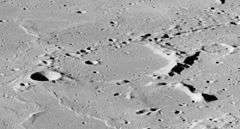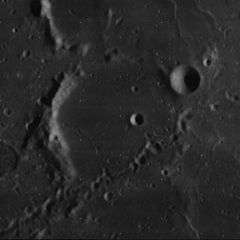Gould (crater)
|
Lunar Orbiter 4 image | |
| Coordinates | 19°12′S 17°12′W / 19.2°S 17.2°WCoordinates: 19°12′S 17°12′W / 19.2°S 17.2°W |
|---|---|
| Diameter | 34 km |
| Depth | Unknown |
| Colongitude | 17° at sunrise |
| Eponym | Benjamin A. Gould |

Gould is the remnant of a lunar crater formation that lies in the midst of the Mare Nubium, in the southwest quadrant of the Moon. It is located to the east-northeast of the prominent crater Bullialdus, and south of the crater remnant Opelt.
This crater has been flooded by basaltic lava, and only segments of the outer rim still project above the surface of the lunar mare. The most intact section of the rim is the western quadrant, which now forms a curved ridge. There is a shorter segment of surviving rim to the northeast, which is bisected by the crater Gould P. Only small, low ridges remain to outline the original crater to the north and southeast, and the southern rim has been completely destroyed.
A catena, or chain of tiny craters, forms a line running from the southern part of the crater floor towards the eastern part. The craters are probably secondaries from Bullialdus.
Satellite craters
By convention these features are identified on lunar maps by placing the letter on the side of the crater midpoint that is closest to Gould.
| Gould | Latitude | Longitude | Diameter |
|---|---|---|---|
| A | 19.2° S | 17.0° W | 3 km |
| B | 20.5° S | 18.4° W | 3 km |
| M | 17.7° S | 17.2° W | 41 km |
| N | 18.4° S | 17.6° W | 17 km |
| P | 18.8° S | 16.6° W | 8 km |
| U | 18.2° S | 14.9° W | 2 km |
| X | 20.9° S | 16.9° W | 3 km |
| Y | 20.6° S | 15.8° W | 3 km |
| Z | 19.5° S | 15.1° W | 2 km |
References
- Andersson, L. E.; Whitaker, E. A. (1982). NASA Catalogue of Lunar Nomenclature. NASA RP-1097.
- Blue, Jennifer (July 25, 2007). "Gazetteer of Planetary Nomenclature". USGS. Retrieved 2007-08-05.
- Bussey, B.; Spudis, P. (2004). The Clementine Atlas of the Moon. New York: Cambridge University Press. ISBN 978-0-521-81528-4.
- Cocks, Elijah E.; Cocks, Josiah C. (1995). Who's Who on the Moon: A Biographical Dictionary of Lunar Nomenclature. Tudor Publishers. ISBN 978-0-936389-27-1.
- McDowell, Jonathan (July 15, 2007). "Lunar Nomenclature". Jonathan's Space Report. Retrieved 2007-10-24.
- Menzel, D. H.; Minnaert, M.; Levin, B.; Dollfus, A.; Bell, B. (1971). "Report on Lunar Nomenclature by the Working Group of Commission 17 of the IAU". Space Science Reviews. 12 (2): 136–186. Bibcode:1971SSRv...12..136M. doi:10.1007/BF00171763.
- Moore, Patrick (2001). On the Moon. Sterling Publishing Co. ISBN 978-0-304-35469-6.
- Price, Fred W. (1988). The Moon Observer's Handbook. Cambridge University Press. ISBN 978-0-521-33500-3.
- Rükl, Antonín (1990). Atlas of the Moon. Kalmbach Books. ISBN 978-0-913135-17-4.
- Webb, Rev. T. W. (1962). Celestial Objects for Common Telescopes (6th revised ed.). Dover. ISBN 978-0-486-20917-3.
- Whitaker, Ewen A. (1999). Mapping and Naming the Moon. Cambridge University Press. ISBN 978-0-521-62248-6.
- Wlasuk, Peter T. (2000). Observing the Moon. Springer. ISBN 978-1-85233-193-1.
